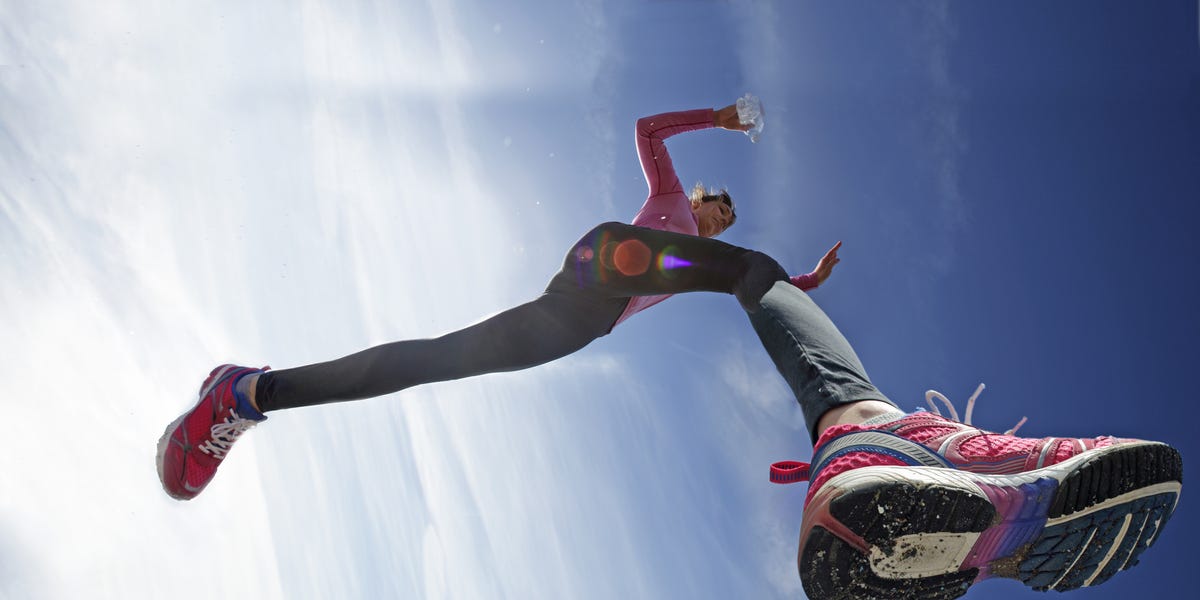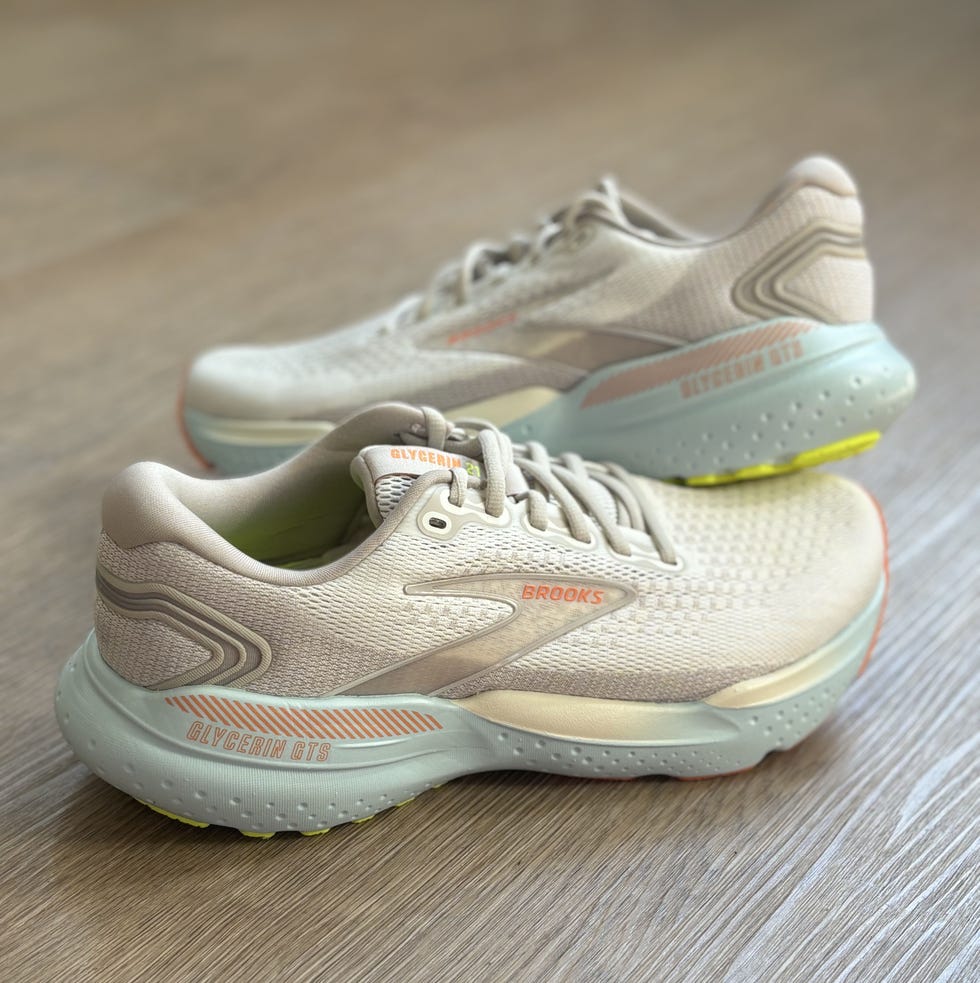As a longtime distance runner, I’m well aware of how crucial it is to replace your running shoes regularly. But I’m also kind of thrifty, and I like to squeeze every mile possible out of my shoes before I have to shell out for a new pair. I end up toeing the line every time and wear them into the ground, and I wonder if I’ll end up injuring myself in the process. This begs the question: How often should you be replacing your running shoes?
“Running shoes—like all shoes—gradually lose cushioning and support over the life of the shoe,” says Richard H. Graves, DPM, a podiatrist at Sol Foot & Ankle Centers in Longwood, California. “So, with every step, you’re getting a tiny bit less than the step before.”
As your shoes wear out, “the mechanics of your running start to go with it,” says Cody Hodgins, an ACE-certified personal trainer and running coach in Charlotte, North Carolina. Older running shoes can also mess with the spring in your step, increasing the amount of force you need to drive forward with each step, Hodgins explains. “Add in shifting running mechanics and subtle change in form, and you have a recipe for an overuse injury,” he says.
Still, there’s a wide range thrown around with how long running shoes are good for, and it’s a big one. With that, it’s fair to wonder exactly how often and when to replace your running shoes. Turns out, this isn’t an exact science. But there are specific rules to follow and little nuances to consider when it’s finally time to trade in your shoes, according to podiatrists and running coaches. Here’s what they shared.
What Is The Average Lifespan Of Running Shoes?
Many running coaches and podiatrists say the sweet spot to replace running shoes is anywhere from 300 to 500 miles. Most importantly, the American Podiatric Medical Association (APMA), which is the leading medical resource for foot and ankle health, agrees with this amount of mileage.
That doesn’t mean you won’t get that much life out of your running shoes, though. “This varies greatly from brand to brand, and person to person,” says Channing Muller, an RRCA-certified running coach and marathoner based in Chicago, Illinois. “One runner may get 300 miles out of their shoes, while another wearing the same shoes could go for [longer] before needing to be replaced.”
How Do I Know When To Replace My Running Shoes?
While you can rely on the mileage range, that can be tough (and admittedly annoying) to track. But you or your shoes may also show some physical signs of wear and tear that can tip you off that it’s time to trade them in. These are the biggies:
Your midsole is compressed: The midsole of your shoe is that cushiony layer between the outsole (bottom) and insole of your sneaker. Worn-out shoes have a flattened or compressed midsole, according to Anne Sharkey, DPM, a podiatrist at Solely Podiatry in Austin, TX. “This will look like wrinkles or creases in the midsole,” she says.
You’re ‘into the white’ with your outsole: This means that you’ve worn through the outer layer of your shoe, and it shows part of the (usually white) midsole when you look at the bottom of your shoes, Graves says.
You have new aches and pains: If you start feeling new aches and pains in your feet or legs for no apparent reason, it could be a sign that your shoes need to be retired, Graves says.
Your shoe’s upper is thinned out: This can lead to a feeling that your shoe is less springy or responsive, Hodgins says. “If it feels like you’re feeling the ground a little too much, it’s time for a new shoe,” he says.
New shoes just feel better: Graves suggests this hack if you think you might need a new pair of shoes, but you’re not sure—go to a store and try on a new pair. “When you feel the difference between those and the ones you’re wearing, you’ll be convinced that you should replace your shoes,” he says.
All of that said, Graves says there aren’t always obvious physical signs that you need to replace your shoes, making it important to at least try to stay on top of your mileage.
Should I Rotate My Running Shoes?
It depends. “Do all runners need multiple pairs of shoes? No. Can it be helpful? Yes,” says Danielle Hirt, CPT, a running coach in Arlington, Virginia. Having lighter shoes for speed work and more supportive shoes for longer runs can help with the different cushioning and support you need for individual workouts, she points out.
Additionally, WH fitness commerce editor Nicolette Accardi advises on switching out shoes after each race training cycle. “It makes it easier to estimate how many miles I’ve logged, plus after training, they usually look pretty beat,” she says. Ultimately, it depends on what kind of race you’re training for, so use good judgment.
If you run regularly, and your budget allows for it, it’s not a bad idea to have multiple pairs of running shoes that you rotate through, Sharkey says. “Rotation of shoes gives the midsole time to decompress between runs, which can extend the life of the shoe,” she says. “Rotation also helps to reduce repetitive strain on the same muscles and joints, especially if the shoes have slightly different designs or cushioning systems.”
Rotating shoes can even help your pair completely dry out before you wear them again, Graves says. “Shoes that are still damp from perspiration from the prior day’s run are going to wear down more quickly and put you at greater risk of injury,” he says.
Should I Avoid Wearing My Running Shoes For Walks?
Every mile you log with your shoes counts, whether you’re walking or running in them, Sharkey says. “Walking occasionally in your running shoes is fine, but using them for all-day wear or frequent walks can accelerate midsole breakdown, shortening their effective running lifespan,” she says. Plus, not all running shoes are good for walking.
Graves agrees. “In general, it’s better to have your running shoes dedicated only to the time you spend running,” he says. “The way your foot interacts with the ground is different when you run than when you walk.” But there is a little leeway here—he adds you can probably get away with using the same pair if you run 10 miles or less per week.
Of course, if you’re dealing with foot, ankle, or knee pain, and you’re unsure if your shoes are the culprit, it’s a good idea to check in with a podiatrist. They can look at your footwear to see what’s going on and if it’s finally time to trade in your trusty pair.
Running Shoes For Women We Love
Meet The Experts
- Richard H. Graves, DPM, is a podiatrist at Sol Foot & Ankle Centers in Longwood, CA.
- Cody Hodgins is an ACE-certified personal trainer and running coach in Charlotte, NC.
- Danielle Hirt, CPT, is a running coach in Arlington, VA.
- Channing Muller is an RRCA-certified running coach and marathoner based in Chicago, IL.
- Anne Sharkey, DPM, is a podiatrist at Solely Podiatry in Austin, Texas.
More Of The Best Sneakers For Women
Best Motion Control Shoes | Best Treadmill Walking Shoes | Best Walking Shoes For Flat Feet | Best Cross Training Sneakers | Best Running Shoes For Women | Best On Cloud Shoes For Walking | Most Comfortable Shoes | Walking Shoes For Women Over 50 | Best Nike Walking Shoes | Best Walking Shoes For Plantar Fasciitis | Hoka Vs. On Cloud
Korin Miller is a freelance writer specializing in general wellness, sexual health and relationships, and lifestyle trends, with work appearing in Men’s Health, Women’s Health, Self, Glamour, and more. She has a master’s degree from American University, lives by the beach, and hopes to own a teacup pig and taco truck one day.
Nicolette Accardi is the Fitness Commerce Editor at Women’s Health with a specialty in running content. She likes to chase her next best time by testing out shoes and other running gear while training for races. Nicolette studied journalism and health sociology at Rutgers University. She has written for NJ.com, VICE, Rolling Stone, NBC News Select, and U.S. News & World Report.
Read the full article here








